2024届广东高考英语听说模仿朗读辅音部分训练课件(共127张PPT)
文档属性
| 名称 | 2024届广东高考英语听说模仿朗读辅音部分训练课件(共127张PPT) | 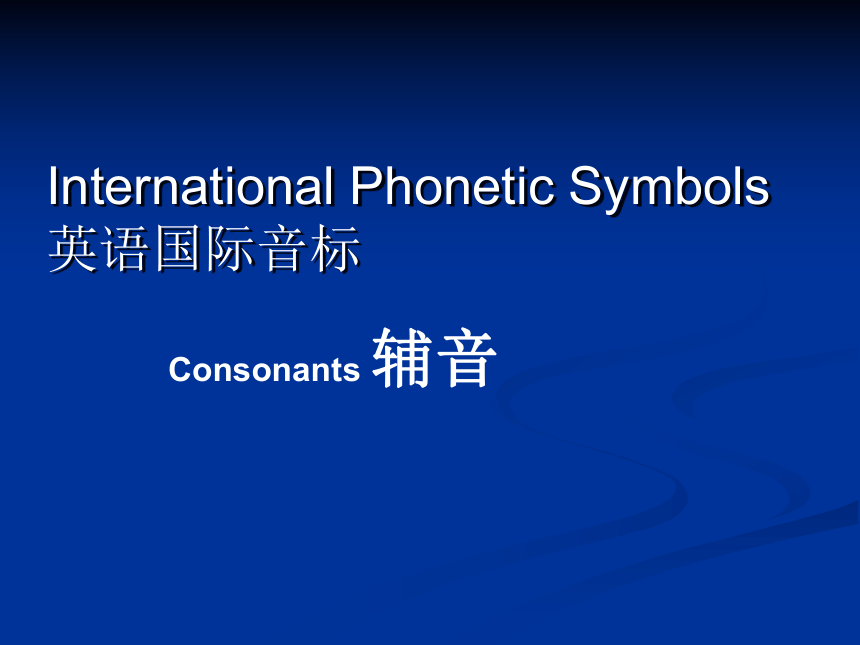 | |
| 格式 | pptx | ||
| 文件大小 | 4.1MB | ||
| 资源类型 | 教案 | ||
| 版本资源 | 通用版 | ||
| 科目 | 英语 | ||
| 更新时间 | 2024-03-02 09:59:49 | ||
图片预览

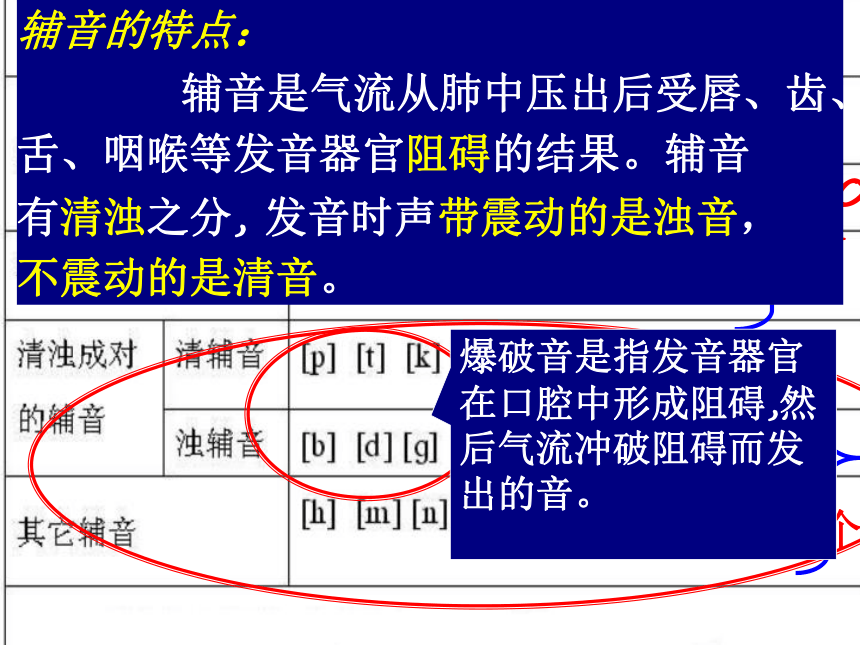
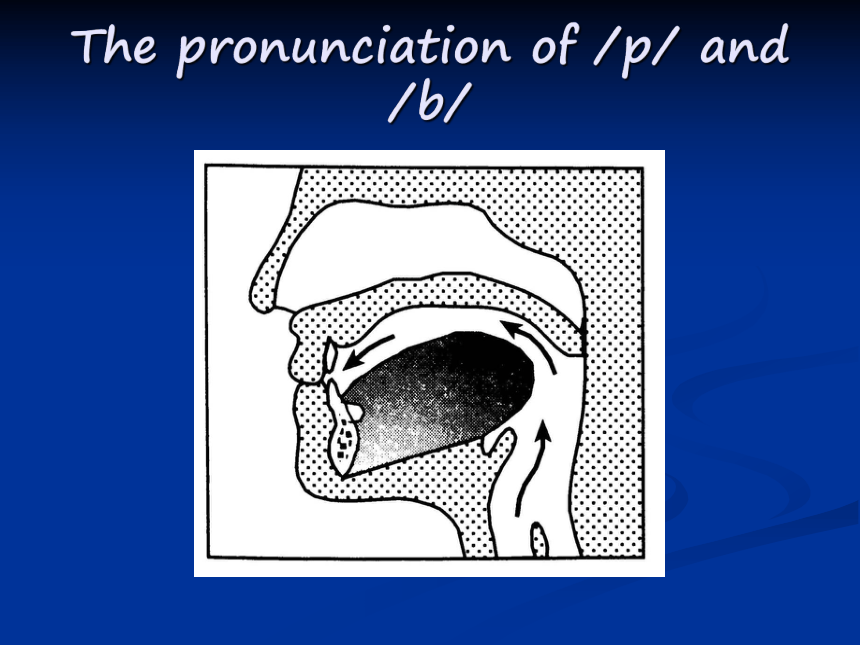
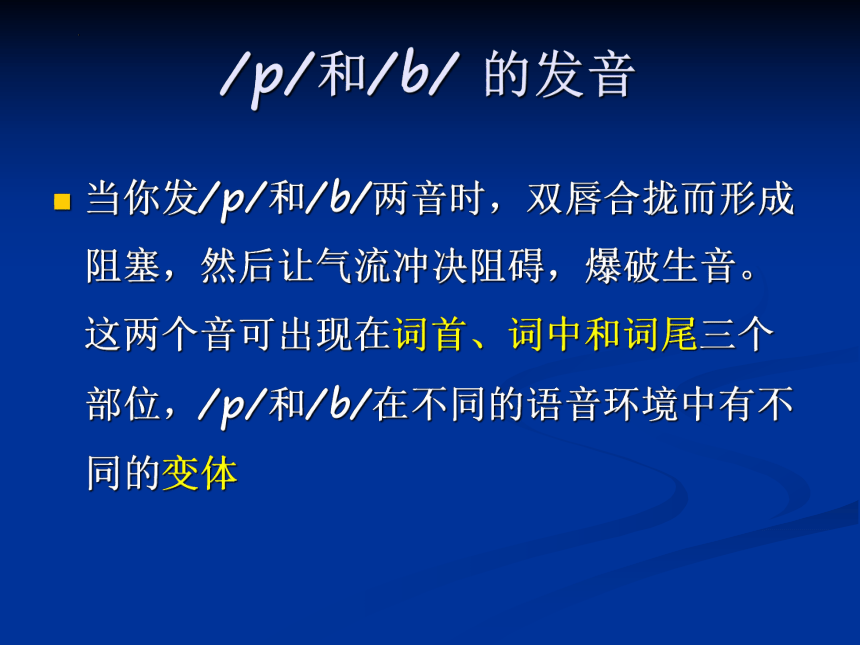
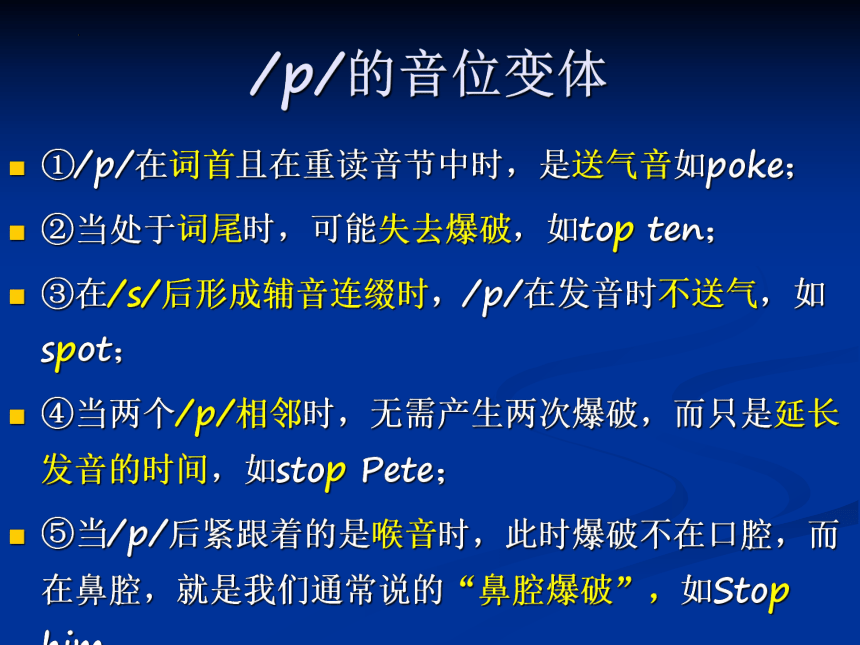
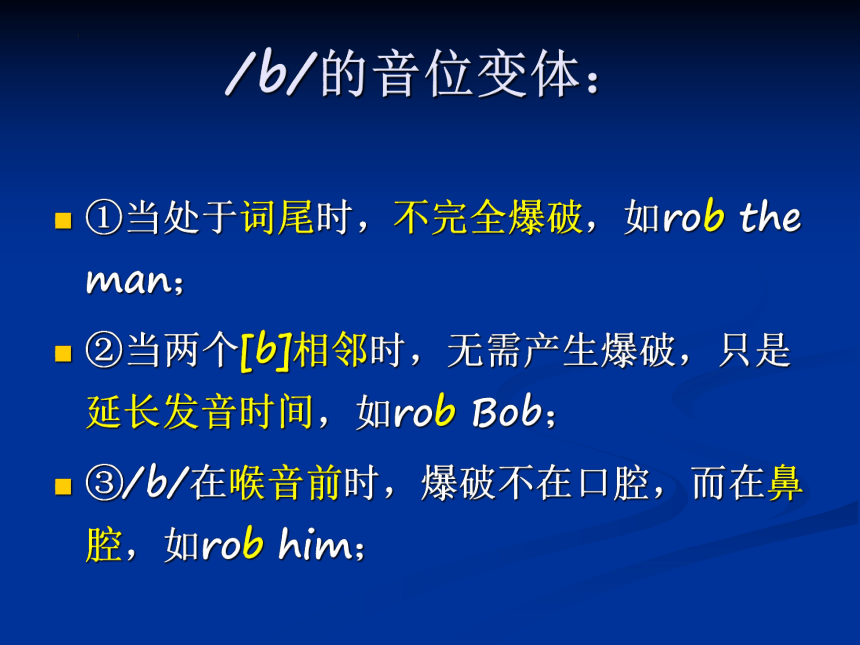
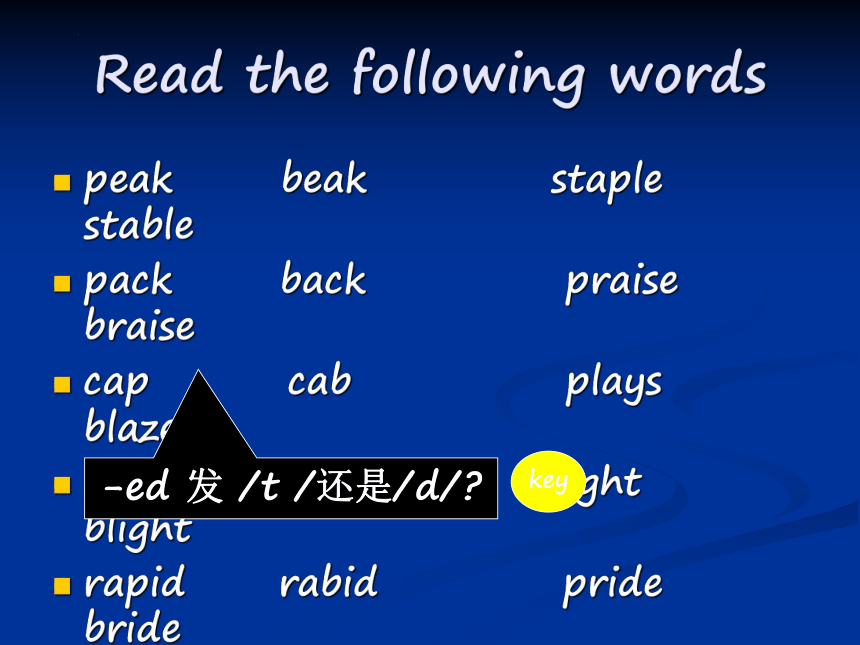
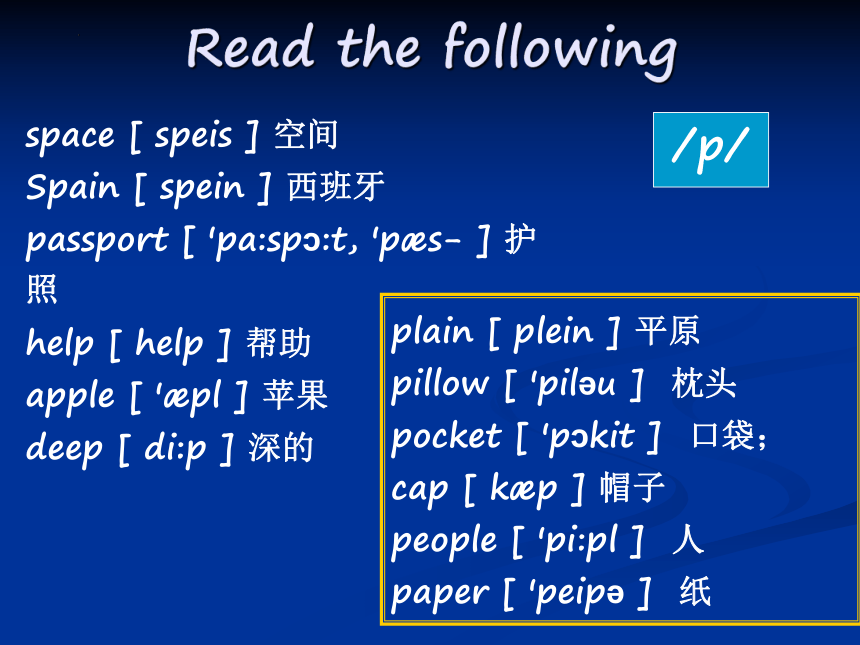
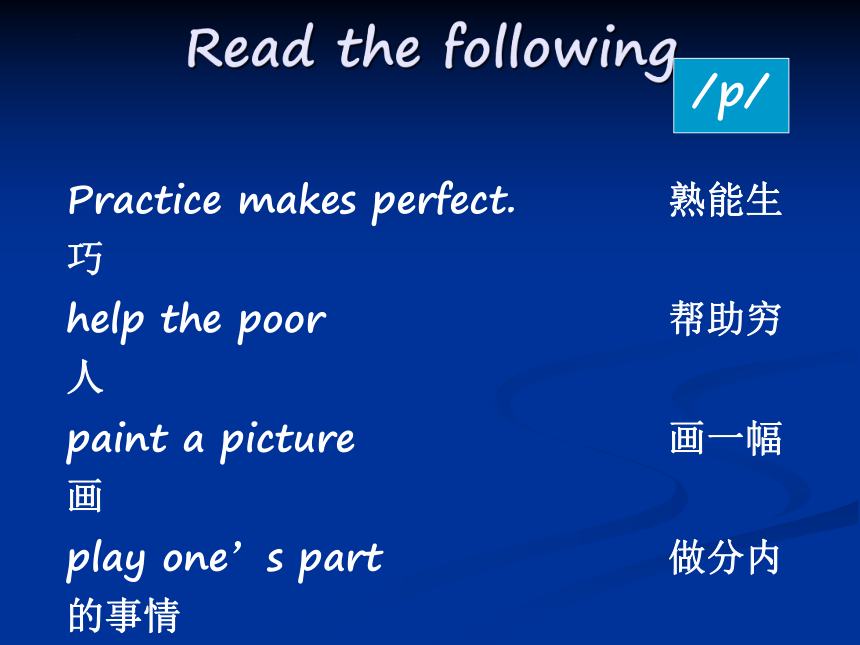
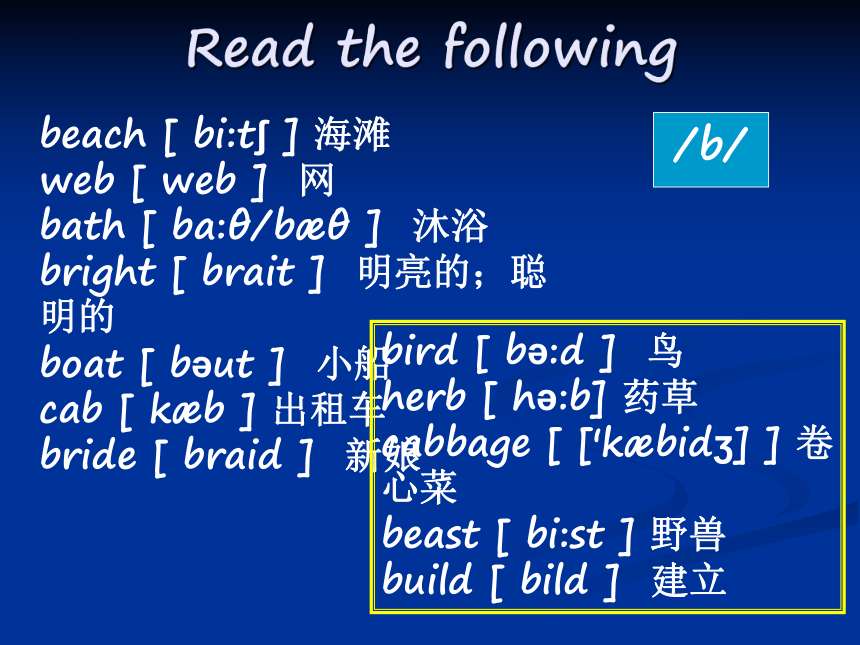
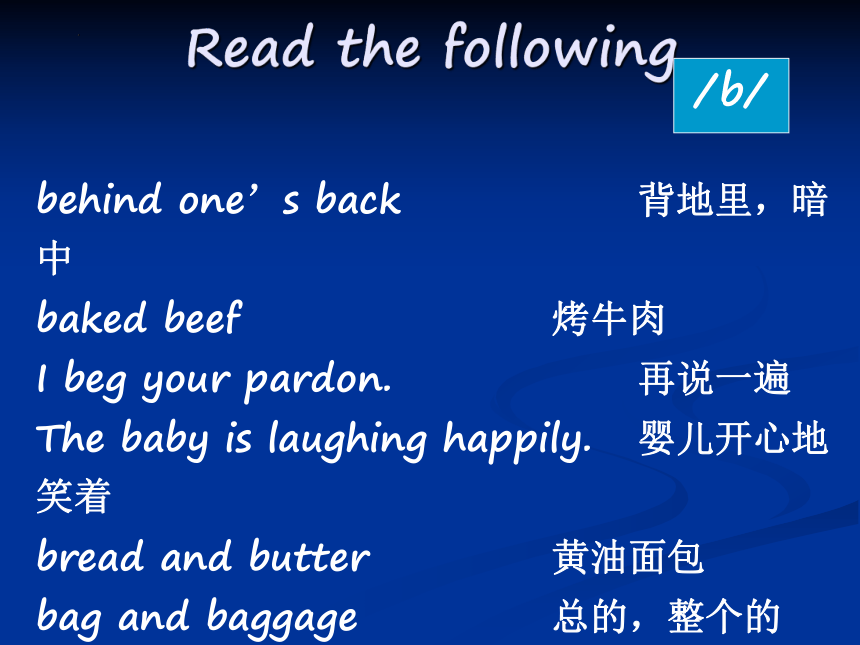
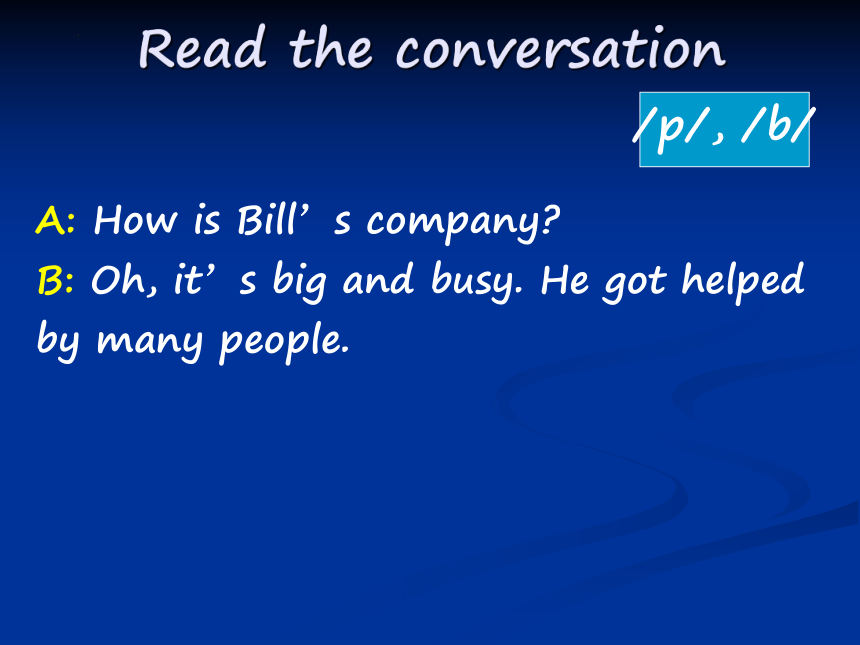
文档简介
(共127张PPT)
International Phonetic Symbols 英语国际音标
Consonants 辅音
20个
28个
爆破音是指发音器官在口腔中形成阻碍,然后气流冲破阻碍而发出的音。
辅音的特点:
辅音是气流从肺中压出后受唇、齿、
舌、咽喉等发音器官阻碍的结果。辅音
有清浊之分, 发音时声带震动的是浊音,
不震动的是清音。
The pronunciation of /p/ and /b/
/p/和/b/ 的发音
当你发/p/和/b/两音时,双唇合拢而形成阻塞,然后让气流冲决阻碍,爆破生音。这两个音可出现在词首、词中和词尾三个部位,/p/和/b/在不同的语音环境中有不同的变体
/p/的音位变体
①/p/在词首且在重读音节中时,是送气音如poke;
②当处于词尾时,可能失去爆破,如top ten;
③在/s/后形成辅音连缀时,/p/在发音时不送气,如spot;
④当两个/p/相邻时,无需产生两次爆破,而只是延长发音的时间,如stop Pete;
⑤当/p/后紧跟着的是喉音时,此时爆破不在口腔,而在鼻腔,就是我们通常说的“鼻腔爆破”,如Stop him;
/b/的音位变体:
①当处于词尾时,不完全爆破,如rob the man;
②当两个[b]相邻时,无需产生爆破,只是延长发音时间,如rob Bob;
③/b/在喉音前时,爆破不在口腔,而在鼻腔,如rob him;
Read the following words
peak beak staple stable
pack back praise braise
cap cab plays blaze
napped nabbed plight blight
rapid rabid pride bride
-ed 发 /t /还是/d/
key
Read the following
space [ speis ] 空间
Spain [ spein ] 西班牙
passport [ 'pɑ:sp :t, 'p s- ] 护照
help [ help ] 帮助
apple [ ' pl ] 苹果
deep [ di:p ] 深的
plain [ plein ] 平原
pillow [ 'pil u ] 枕头
pocket [ 'p kit ] 口袋;
cap [ k p ] 帽子
people [ 'pi:pl ] 人
paper [ 'peip ] 纸
/p/
Read the following
Practice makes perfect. 熟能生巧
help the poor 帮助穷人
paint a picture 画一幅画
play one’s part 做分内的事情
a piece of paper 一张纸
a bit of pity 有点可惜
/p/
Read the following
beach [ bi:t ] 海滩
web [ web ] 网
bath [ bɑ:θ/b θ ] 沐浴
bright [ brait ] 明亮的;聪明的
boat [ b ut ] 小船
cab [ k b ] 出租车
bride [ braid ] 新娘
/b/
bird [ b :d ] 鸟
herb [ h :b] 药草
cabbage [ ['k bid ] ] 卷心菜
beast [ bi:st ] 野兽
build [ bild ] 建立
Read the following
behind one’s back 背地里,暗中
baked beef 烤牛肉
I beg your pardon. 再说一遍
The baby is laughing happily. 婴儿开心地笑着
bread and butter 黄油面包
bag and baggage 总的,整个的
/b/
Read the conversation
A: How is Bill’s company
B: Oh, it’s big and busy. He got helped by many people.
/p/, /b/
The pronunciation of /t/ and /d/
/t/和/d/ 的发音
/t/和/d/是齿龈爆破音. 发这两个音时,用舌尖抵齿龈成阻,让气流爆发而出。
/t/的音位变体
1. /t/在词首且在重读音节中时,是送气音如tape;
2. 当处于词尾时,可能失去爆破,如sit still;
3. 在/s/后形成辅音连缀时,/t/在发音时不送气,如stop;
4. 当/t/后紧跟着的是鼻音时,此时爆破不在口腔,而在鼻腔,就是通常说的“鼻腔爆破”,如button;
5.当/t/位于成音节/n/或/l/前时,便成了声门爆破音,如little;
7.当两个/t/相邻时,无需产生两次爆破,而只是延长发音的时间,如let Tim;
8.当处于辅音组合/tr/中时,发音兼具爆破与摩擦的特征,如train;
/d/的音位变体:
1. 当处于词尾时,不完全爆破,如Dad said so.
2. /d/在鼻音前时,爆破不在口腔,而在鼻腔,如bread’n butter;
3. 当两个/d/相邻时,无需产生爆破,只是延长发音时间,如sad Dave
4. 当处于辅音组合/dr/之中时,发音兼具爆破和摩擦的特征,如drain。
Read the following
tip dip bet bed
tan dan beetle beadle
toe doe spite spied
hit hid heating heading
cot cod try dry
Read the following
table [ 'teibl ] 桌子
cotton [ 'k t n ] 棉花
hot [ h t ] 热的
stair [ stε ] 楼梯
eat [ i:t ] 吃
stand [ st nd ] 站立
star [ stɑ: ] 星
water [ 'w :t , 'w - ] 水
tea [ ti: ] 茶
team [ ti:m ] 队
fat [ f t ] 肥的
better [ bet ] 更好的
/t/
Read the following
turn tail 退走,逃跑
an important meeting 一个重要的会议
tell tales 讲人坏话,搬弄是非
at times 有时
put on your coat 穿上你的外套
not at all 一点儿也不
/t/
Read the following
day [ dei ] 天
doctor [ d kt ] 医生
dare [ dε ] 敢
dance [ dɑ:ns, d ns ] 舞蹈
deep [ di:p ] 深
dip [ dip ] 浸,泡
good [ ɡud ] 好的
dark [ 'dɑ:k ] 黑暗的
do [ 强du:, 弱du, d , d, du: ] 做
code [ k ud ] 代码
/d/
Read the following
after death, the doctor 放马后炮
a different idea 一个与众不同的想法
day by day 每日,逐日
a cold day 寒冷的天气
cry aloud suddenly 突然大声喊
a good child 一个好孩子
/t/
Read the conversation
A: Why did Tom look so sad
B: He has failed the test.
A: Oh, it is really a pity.
/t/, /d/
The pronunciation of /k/ and /g/
/k/和/g/ 的发音
发/k/和/g/两音时,用舌根顶住软腭堵住气流的出路,然后舌根猛地离开软腭使气流爆发而出。/k/是清辅音,/g/是浊辅音。
/k/的音位变体
①/k/位于词首,且在重读音节中时,是送气音,如keep;
②当处于词尾时,可能失去爆破,如take three;
③在/s/后形成辅音连缀时,/k/在发音时不送气,如sky
④当两个/k/相邻时,无需产生两次爆破,而只是延长发音的时间,如take Kim;
⑤当/k/后紧跟着的是鼻音时,此时爆破不在口腔,而在鼻腔,就是我们通常说的“鼻腔爆破”,如beacon;
⑥后跟前元音时,/k/的发音部位前移,如keen;
⑦位于圆唇音之前时,发音时亦呈圆唇,如quarter.
/g/的音位变体
①当处于词尾时,不完全爆破,如lag behind;
②当两个/g/相邻时,无需产生爆破,只是延长发音时间,如big grapes
③/g/在鼻音前时,爆破不在口腔,而在鼻腔,如pig and goat;
④后跟前元音时,发音部位前移,如geese;
⑤位于圆唇音之前时,发音时亦呈圆唇,如goose.
Read the following
Kate gate bet bed
Coat goat sacking sagging
Cut gut bicker bigger
Pick pig crime grime
Lock log close glows
Read the following
pick up 捡起,接
quite a character 很有性格的人
as clear as crystal 非常清晰、清澈
take care 当心
beg for 祈求
back countries 穷乡僻壤
/k/
Read the following
guide a character 引导角色
give a glance 看一眼
green grass 绿色的草
(as) good as gold 完美,难能可贵
get your luggage 去拿行李
/g/
Read the conversation
A: Where shall we park the car
B: We may park the car beside the garden.
A: That’s ok.
/k/, /g/
爆破音的不完全爆破
a(c)tor, ne(ck)tie, bla(ck)board
Si(t) down. I can’(t) come.
I don’(t) believe he is a ba(d) boy. 等。
Read the following
Read the following
Ben bought Bobby a boy's club book.
David drew different daffodils.
Kevin kept Kate as keen as a kitten.
People make pretty patterns in their soup.
Quaint quiz questions about quite quiet liquids.
Ten tiny teddies talked to Tony.
[ 'd f dil ] n. 水仙花
quaint [ kweint ] adj. 奇怪的
不完全爆破、鼻腔爆破和音的延长
根据录音,选出所听到的词。
听力强化练习
爆破音/p/, /b/
8(8’23)
pack back
cap cab
port bought
cup cub
pay bay
sop sob
robe rope
buy pie
9. peat beat
10. pride bride
11. tap tab
12. rip rib
13. nip nib
14. pin bin
15. pet bet
16. pat bat
17. pear bear
根据录音,选出所听到的词。
听力强化练习
爆破音/p/, /b/
8(8’23)
pack back
cap cab
port bought
cup cub
pay bay
sop sob
robe rope
buy pie
9. peat beat
10. pride bride
11. tap tab
12. rip rib
13. nip nib
14. pin bin
15. pet bet
16. pat bat
17. pear bear
根据录音,选出所听到的词。
听力强化练习
爆破音/k/, /g/
9(9’19)
dick dig
back bag
tuck tug
duck dug
curl girl
cave gave
crow grow
pick pig
9. dock dog
10. leck leg
11. class glass
根据录音,选出所听到的词。
听力强化练习
爆破音/k/, /g/
9
dick dig
back bag
tuck tug
duck dug
curl girl
cave gave
crow grow
pick pig
9. dock dog
10. leck leg
11. class glass
9(9’19)
根据录音,选出所听到的词。
听力强化练习
爆破音/t/, /d/
10(9’55)
Ton done
Town down
Tide die
Bet bed
Late laid
Sight side
Brought broad
Tie die
9. Class glass
10. Too do
11. Tear dear
12. Toe dough
13. Sent send
14. Eight aid
15. Rate raid
16. Great grade
根据录音,选出所听到的词。
听力强化练习
爆破音/t/, /d/
10
Ton done
Town down
Tide die
Bet bed
Late laid
Sight side
Brought broad
Tie die
9. Class glass
10. Too do
11. Tear dear
12. Toe dough
13. Sent send
14. Eight aid
15. Rate raid
16. Great grade
10(9’55)
Fricatives
摩擦音
Fricatives: / f / / v / / θ / / /
/s/ / z / /∫ / / / / h /
20个
28个
辅音的特点:
辅音是气流从肺中压出后受唇、齿、舌、咽喉等发音器官阻碍的结果。辅音有清浊之分, 发音时声带震动的是浊音,不震动的是清音。
摩擦音是指发音时气流部分受阻,但气流仍可通过受阻部位的狭小缝隙,通过摩擦的方式而发音。
The pronunciation of / f / / v /
/ f / / v / 的发音
/ f /和/ v /是唇齿音。前者是清辅音,后者是浊辅音。发音时,上齿紧挨下唇,然后将气流向外挤出。
对于大多数中国学生来说,发好/ f /不成问题,/ v /则不然。有些人都把/ v /发成双唇音/ w/或/ b /。此外,人们的发音中还出现将/ v /清音化的趋势,即用/ f /代替/ v /,特别是/ v /在词尾的时候。
Read the following
fleet [ fli:t ] 舰队
coffee [ 'k fi ] 咖啡
enough [ i'n f ] 足够
fix [ fiks ] 使固定;修理
phone [ f un ] 电话
finger [ 'fi ɡ ] 手指
flat [ fl t ] 平坦的;公寓
stiff [ stif ] 呆板的;坚硬的
proof [ pru:f ] 证明;证据
half [ hɑ:f, h f ] 一半
/ f /
Read the following
sharp knife 锋利的刀
feel fine 感觉不错
far from it 远非如此
face to face 面对面
fight fire with fire 以毒攻毒
a famous film star 一位著名的电影明星
/ f /
Read the following
The fisher sells fresh fish.
The butterfly likes flowers.
A: Why did you take French leave last Friday
B: Family emergency.
an abrupt and unannounced departure (without saying farewell)
/ f /
Read the following
active [ ' ktiv ] 积极的;活跃的;
dove [ d v ] 鸽子
clever [ 'klev ] 聪明的
victor [ 'vikt ] 胜利者
vest [ vest ] 背心
cave [ keiv ] 洞穴
view [ vju: ] 视野;意见
brave [ breiv ] 勇敢的
veil [ veil ] 面纱
/ v /
Read the following
various views 各种各样的观点
marvelous achievement 了不起的成就
over and over again 一次又一次地
negative virtue 消极的美德
an invalid visa 一张无效的签证
a very hot oven 一个非常热的炉子
/ v /
Van is a kind of vehicle.
The visitor went to the village.
[ 'vi:z ]
[ ' v n ]
[ 'vi:ikl]
['v :tju: ]
The pronunciation of /θ/ and / /
/θ/ and / /的发音
/ θ / 和 / /是齿间音。发音时,舌尖抵及上齿内侧,或置于上下齿之间,舌身平放口中,气流从舌尖与上下齿之间形成的缝隙中挤出,摩擦生音。/ θ /是清辅音,/ /是浊辅音。
发/ θ /时舌尖和上齿间的缝隙不能堵住,气流受堵就不能发生摩擦。
发/ /音时,舌尖向下用力,用上齿接触舌尖上面。
Read the following
thumb [ θ m ] 拇指
thief [ θi:f ] 小偷
those [ uz ] 那些
throat [ θr ut ] 喉咙
bath [ bɑ:θ/b θ ] 沐浴
thirsty [ 'θ :sti ] 口渴的
/ θ /
health [ helθ ] 健康
thrift [ θrift ] 节俭
breath [ breθ ] 呼吸
teeth [ ti:θ ] 牙齿
death [ deθ ] 死
north [ n :θ ] 北,北方
Read the following
through thick and thin 顽强地,在任何情形下
north and south 北方和南方
thousands of 数以千计的
from mouth to mouth 广泛流传
set a thief to catch a thief 以毒攻毒
the Fifth Avenue 第五大街
/ θ /
I think you should thank him.
How do you think of Cathy
Read the following
breathe [ bri: ] vi. 呼吸
soothe [ su: ] vt. 安慰
weather [ 'we ] 天气
these [ i:z ] 这些
brother [ 'br ] 兄弟
/ /
thus [ s ] 因此
leather [ 'le ] 皮革
there [ ε , 弱 , r ] 那里
other [ ' ] 其他的
worthy [ 'w : i ] 值得的
they [ ei, 弱 e ] 他们
Read the following
this and that
又是这个…又是那个;各种各样的东西
bathe in the sunny weather 沐浴在灿烂的阳光中
father’s brothers 父亲的兄弟
then and there 就在当时当地
/ /
This one is better than that.
My father and mother smiled.
Read the following
A: What do you think of my new clothes
B: Though they look beautiful, they are a little thin if you wear them now, I think.
clothe[ kl u ] vt. 给…穿衣;覆盖
clothes [ kl u z ] n. 衣服
clothing [ ‘kl u i ] n. (总称)服装
cloth [ kl θ, kl :θ ] n. 布,织物
/ /
The pronunciation of /s/ /z/
/s/ /z/ 的发音
/s/和/z/是齿龈音。发音时,舌尖抵上齿龈,气流从舌前端与齿龈间挤出,产生磨擦。/s/是清辅音,/z/是浊辅音。/s/在英语中出现频率很高,因为它可以帮助构成所有格(如Kate ‘s), 主语为第三人称单数的动词现在时(如takes)和名词复数(如seats)。/z/在构成所有格(如Susan’s),主语为第三人称单数的动词的现在时(runs)和名词复数(dogs)时,也发挥了同样重要的语法功能。
名词复数 -s/-es 发/s/, /z/还是/iz/
名词复数形式时词尾s的发音规则:
1)s在[p],[t],[k],[f]等清辅音后发[s];
2)s在[s],[z], sh, ch等音后发[z];
3)其他情况下发[z]。
1. 元音和辅音哪个响亮?
2. 清辅音和浊辅音哪个响亮?
3. /s/和/z/哪个响亮?
4. [ps],[ts],[ks],[fs] 顺口还是[fz],[kz],[pz],[tz] 顺口?
s在[p],[t],[k],[f]等清辅音后发[s];
在其他情况下(即在浊辅音和元音后)发[z]。
名词复数-s发/s/, /z/还是/iz/
名词复数形式时词尾s的发音规则:
[s],[z], sh, ch为结尾,比如单词 bus, fox, dish, watch,等,这些单词的结尾音有一个一致的特点,就是和[s]的发音一样或特别接近,这使得若在这些单词的后面直接加个s来表达复数的话,成为buss, foxs, dishs, watchs
s之间塞个e,变成buses, foxes, dishes, watches,并且让e发音为[i],这样一来不就把两个相似的s的发音间隔开了 。
e发/i/,它什么音?
/i/是 “响亮音” 还是“不响亮音”?
1)S在清辅音后发[s]
2)S在浊辅音或元音后发[z]。
或者这样记忆:
1)S在不响亮音后发[s]
2)S在响亮音后发[z]。
Read Aloud
① stop-stops [s] ; make-makes [s]
read-reads [z] ; play-plays [z]
② go-goes [z]; do-does [z]
③ do [du:]-does [z]; say [sei]-says [sez]
④ trees and bees
⑤ likes and dislikes
Read Aloud
1、
cups 杯子
days 日子
hands 手
hats 帽子
2、
classes 班级
buses 公交
boxes 盒子
watches 手表
3、
boy-boys 男孩
army-armies 军队
story-stories 故事
factory-factories 工厂
baby-babies 宝贝
4、
kilo-kilos 公里
photo-photos 照片
tobacco-tobaccos 烟草
piano-pianos 钢琴
5、
zoo-zoos 动物园
radio-radios 收音机
6、
tomato-tomatoes 西红柿
hero-heroes 英雄
potato-potatoes 土豆
7、
leaf-leaves 树叶
thief-thieves 小偷
wife-wives 妻子
knife-knives 小刀
shelf-shelves 架子
Read the following
swim rice
scissors face
sea sick
miss see
bus say
race scene
/ s /&/z/
zipper[ 'zip ] magazine
zero his
size zoo
please seize
possess [ p 'zes ] zebra
process seize
zoo zone
[ 'siz z ]
[ si:n ]
[ 'pr uses, 'pr - ]
[ z un ]
Read the following
sing a song
唱首歌
be at sixes and sevens
乱七八糟
for old times’ sake
看在旧日情分上
a slight sign
轻声的叹息
seem to
似乎
sink and swim
孤注一掷,成败在此一举
/ s /&/z/
doze off
打瞌睡
cozy clothes
舒适的衣服
nose to nose
鼻子对鼻子
a zebra in the zoo
动物园里的斑马
Nobel Prize
诺贝尔奖
examine her disease
检查她的病症
根据录音,选出所听到的词。
听力强化练习
摩擦音/f/, /v/
12(11’28)
staff starve
safe save
feel veal
fine vine
folk vote
fail veil
life live
cuff carve
9. doff dive
10. fast vast
11. leaf leave
12. proof prove
13. ferry very
14. shuttle shovel
根据录音,选出所听到的词。
听力强化练习
摩擦音/f/, /v/
12
staff starve
safe save
feel veal
fine vine
folk vote
fail veil
life live
cuff carve
9. doff dive
10. fast vast
11. leaf leave
12. proof prove
13. ferry very
14. shuttle shovel
12(11’28)
根据录音,选出所听到的词。
听力强化练习
摩擦音/s/, /z /
13(12’12)
seal zeal
bus buzz
sip zip
course cause
sown zone
police please
7. sink zinc
8. price prize
9. loose lose
10. rice rise
11. dust does
根据录音,选出所听到的词。
听力强化练习
摩擦音/s/, /z /
13
seal zeal
bus buzz
sip zip
course cause
sown zone
police please
7. sink zinc
8. price prize
9. loose lose
10. rice rise
11. dust does
13(12’12)
根据录音,选出所听到的词。
听力强化练习
摩擦音/θ /, / /
14(12’50)
thin then
think this
lacer laser
loss laws
thief these
think that
sick thick
seize seals
9. closing clothing
10. Fred thread
11. free three
12. bath bathe
13. thirst thus
14. both booth
15. mouth mouse
根据录音,选出所听到的词。
听力强化练习
摩擦音/θ/, / /
14
thin then
think this
lacer laser
loss laws
thief these
think that
sick thick
seize seals
9. closing clothing
10. Fred thread
11. free three
12. bath bathe
13. thirst thus
14. both booth
15. mouth mouse
14(12’50)
The pronunciation of /∫/ /3/
/∫/ / / 的发音
/ ∫ /和/ /是腭龈摩擦音。发/ ∫ /和/ /时,舌头在口腔中的位置比发/s/与/z/时靠后,整个舌面举平抬向硬腭,双唇略突出。/ ∫ /是清辅音,/ /是浊辅音。
Read the following
ship [ ip ] 船
shrimp [ rimp ] 虾
shoot [ u:t ] 射击
mustache [ m 'stɑ: , 'm st ] 胡子
wash [ w , w : ] 洗
shirt [ :t ] 衬衫
shame [ eim ] 羞耻
shout [ aut ] 呼喊
chef [ ef ] 厨师
she [ i: ] 她
sugar [ ' uɡ ] 糖
ocean [ ' u n ] 海洋
/ ∫ /
Read the following
a shadow of a shade 海市蜃楼
shake hands 握手
share the sunshine 享受阳光
shrug one’s shoulder 耸耸肩
pay attention 注意
a shining machine 闪闪发光的机器
/ ∫ /
A: Would you like to have some sugar
B: Sure. I’m writing an essay. Could you be kind enough to get some for me
Read the following
pleasure [ 'ple , 'plei- ]
快乐
television [ 'teli,vi n, ,teli'v- ] 电视
garage [ 'ɡ rɑ:d , ɡ 'r- ]
车库
closure [ 'kl u ]
关闭
casual [ 'k ju l ]
随便的
leisure [ ‘le ]
闲暇
seizure [ 'si: ]
没收;夺取;捕获
treasure [ 'tre , 'trei- ]
财富
usual [ 'ju: u l ]
通常的
massage [ 'm sɑ: , m 's- ]
按摩
measure [ 'me ]
测量
prestige [ pre'sti: , -'sti:d , 'prestid ] 威望
/ /
Read the following
on this occasion 在这个场合
the pleasure is mine. 高兴得很,荣幸得很
usual pleasure 一如既往的快乐
see a vision casually 偶尔会看到幻影
at pleasure 随意,随时
unusual conclusion 不寻常的结论
A: I have some illusions on occasion.
B: Don’t watch horror television as usual.
/ /
/ h / 的发音
发/ h /音时,摩擦不发生在口腔中的任何部位,发音时口张开,声门略为收缩,气流通过声门时只有轻微的摩擦,就像人们长出一口气那样,因此人们管它叫声门摩擦音。学习时要注意勿将/ h /发成汉语普通话中的(h)音,因为(h)在发音时,舌根接近软腭,所产生的气流带明显的摩擦。请注意这两个音的区别:“害”(hai) 与 high。
唇形:张开,形状随其后元音而变化。
Read the following
hard
hat
hate
his
help
head
habit
high
hill
hand in hand 手牵手
half-hearted 缺乏热情的
hang by a hair 千钧一发,危在旦夕
hear by herself 她亲耳听到
hunt the wrong hare 错怪某人
hope for help 希望得到帮助
/ h /
Read the following
/ h /
A: I heard our history test paper had twelve pages. I’ve got to cram for it.
我听说历史试卷有12页,我得临时抱佛脚了。
B: Take things easy. Just hope for the best, but prepare for the worst.
不用着急,抱着最好的希望,做好最后坏的打算吧。
根据录音,选出所听到的词。
听力强化练习
摩擦音/ ∫ /和/ /
15(13’37)
sheep jeep
pressure pleasure
hash hatch
shoes choose
short sort
6. fission vision
7. glacier glazier
8. shield sealed
9. shin gin
10. station invasion
根据录音,选出所听到的词。
听力强化练习
摩擦音/ ∫ /和/ /
15
sheep jeep
pressure pleasure
hash hatch
shoes choose
short sort
6. fission vision
7. glacier glazier
8. shield sealed
9. shin gin
10. station invasion
15(13’37)
20个
28个
辅音的特点:
辅音是气流从肺中压出后受唇、齿、
舌、咽喉等发音器官阻碍的结果。辅音
有清浊之分, 发音时声带震动的是浊音,
不震动的是清音。
破擦音破擦音由一个爆破音和一个摩擦音组成
Affricates
破擦音
Affricates: /ts/, /dz/
字母组合tes,ts在单词中发/ts/音;字母组合des,ds在单词中发/dz/音。
Read the following
let's /lets/ 让我们
gets /gets/ 得到
sweets /swi:ts/ 糖果(复)
what's /w ts/ 什么
shirts / : t s/ 衬衣(复)
needs /ni:dz/ 必需品
cards /ka:dz/ 卡(复)
goods /gudz/ 货物
beds /bedz/ 床(复)
roads /r udz/ 道路(复)
/ts/, /dz/
Read the following
lots of
许多
lots of seats
很多座位
eats fruits
吃水果
go nuts
发疯
three cats
三只猫
in the streets
在街上
several brands
几个品牌
make friends
做朋友
comfortable beds
舒适的床
my friends
我的朋友
different minds
不同的想法
several pounds
一些英镑
/ts/, /dz/
Affricates
破擦音
Affricates: /tr/, /dr/
字母组合tr在单词中发/tr/音,字母组合dr在单词中发/dr/音。
Read the following
trip /trip/旅行
true/tru:/真的
truth /tru:θ /真理
train/trein/火车
truck /tr k/卡车
/tr/, /dr/
dream/dri:m/梦
dress /dres/穿衣
draw/dr : /画
drive /draiv/驾驶
drink/dri k /喝
Read the following
get into trouble
陷入麻烦
tell the truth
告诉真是情况
foreign trade
对外贸易
try a pair of trousers on
试一条裤子
another try
另一次尝试
travel by train
乘火车旅行
/tr/, /dr/
dry a dress
晾干一件衣服
drink some wine
喝点红酒
sweet dreams
美梦
hundreds of
成百,许多
drag one’s feet
故意拖延
drive the car
开车
The pronunciation of /t∫/ /d /
/t∫/ /d / 的发音
/t∫/和/d /是破擦音。
/t∫/是清辅音, /d /是浊辅音。
唇形: /t∫/---从/t/的自然张开过渡到/ ∫ /的稍微突出; / d /---从/d/的自然张开过渡到/ /的稍微突出。
Read the following
/t∫/
picture
chat
cheat
temperature
cheer
chance
charming
jeep
chair
cheap
lunch
chain
chat over lunch 午餐时聊天
change the choice 改变选择
too much 太多
cheat on the check 在支票上作假
free of charge 不收费,免费
Read the following
/d /
bridge
danger
jam
general
soldier
George
job
cage
orange
jeans
juice
joking
play jokes 开玩笑
opportunity and challenge 机遇与挑战
in charge of 掌管
jump for joy 欢欣鼓舞
traffic jam 交通阻塞
根据录音,选出所听到的词。
听力强化练习
摩擦音/ t∫ /和/ d /
16(14’15)
What a good (jest chest)!
Look at your (chin gin).
There is something wrong with the (train drain chain).
Will you keep the (peach peas) for us
Where is your (thread dread)
She is (washing watching).
jest [ d est ] n. 笑话,俏皮peas
n. 豌豆(
话
gin [ d in ] n. 杜松子酒
peas n. 豌豆
根据录音,选出所听到的词。
听力强化练习
摩擦音/ t∫ /和/ d /
16(14’15)
7. Did you find the (catch cats)
8. It’s a (mange match).
9. Did you see the (bees beets beech beads)
10. There’s the (drunk chunk junk trunk)
11. Spell the word (chew true drew Jew).
12. How about the (rates race raids rays)
[ meind ]
根据录音,选出所听到的词。
听力强化练习
摩擦音/ t∫ /和/ d /
16(14’15)
What a good (jest chest)!
Look at your (chin gin).
There is something wrong with the (train drain chain).
Will you keep the (peach pees) for us
Where is your (thread dread)
She is (washing watching).
jest [ d est ] n. 笑话,俏皮peas
n. 豌豆(
话
gin [ d in ] n. 杜松子酒
peas n. 豌豆
根据录音,选出所听到的词。
听力强化练习
摩擦音/ t∫ /和/ d /
16(14’15)
7. Did you find the (catch cats)
8. It’s a (mange match).
9. Did you see the (bees beets beech beads)
10. There’s the (drunk chunk junk trunk)
11. Spell the word (chew true drew Jew).
12. How about the (rates race raids rays)
20个
28个
辅音的特点:
辅音是气流从肺中压出后受唇、齿、
舌、咽喉等发音器官阻碍的结果。辅音
有清浊之分, 发音时声带震动的是浊音,
不震动的是清音。
/ m / / n / / / / 的发音
/ m /和/ n /发音简单直接。/ m /是由双唇紧闭发出的音,发音时上下唇紧闭,舌身平放,软腭下垂,气流从鼻腔泄出。/ n /是个齿音,发音时舌头抵住上齿龈。/ /的发音部位与爆破音/ k /相同,舌后部触及软腭,堵塞口腔通道,双唇开,气流从鼻腔泄出。鼻音与爆破音、摩擦音以及破擦音有很大的不同,它具有某些类似元音的性质:可以自成音节。
Read the following
sin sing sinner singer in ink
English [ 'i ɡli ]
thing [ θi ]
long [ l , l : ]
bank [ b k ]
spring [ spri ]
pink [ pi k ]
spring [ spri ]
king [ ki ]
young [ j ]
wing [ wi ]
morning [ 'm :ni ]
/ n / / / /的区别
/ /的练习
Read the following
sing a song 唱一首歌
nothing wrong 没什么错
a long evening 一个漫长的夜晚
a long shopping list 一张长长的购物单
the coming spring 即将到来的春天
/ /的练习
/ w / / j / 的发音
w /和/ j /在三个方面很相似。第一,他们的发音分别与元音 / u: /和/ i: /相似,发音时气流在通道上基本不受阻碍,只是稍有摩擦,因此又被称作半元音。第二,/ w /和/ j /都不出现在英语单词的词尾。第三,他们是浊辅音。发/ j /时双唇呈扁平状,舌向硬腭抬起,略高于元音/ i: /,中间留有小缝隙形成不完全阻碍,气流从缝隙泄出时引起舌前硬腭间摩擦而成音。
现代语音学家将这两个音称作延续音。延续音的发音器官彼此接近,但与所谓“完全的”辅音如爆破音、鼻音以及摩擦音不同的是,它兼具元音与辅音的特点。
Read the following
/ w /
Language
West
Swim
Wave
Wit
Away
What
Waste
Work
Waste
White
once
walk forward 向前走
water the wheat 灌溉小麦
within four walls 私下地,机密地
walk in the woods 在丛林里散步
welcome warmly 热情欢迎
hot weather 热天
East or west, home is best .
Read the following
/ j /
Young
Yellow
Suit
Pupil
Yesterday
Beauty
Value
Yard
Nephew
New
yes
yes or no 是或 不是
the year around 整年
as yielding as wax 十分柔软
make sb. yawn 使人厌倦
yesterday morning 昨天早上
year after year 年复一年
A: Would you like some yogurt
B: Sure. I’m writing a yearbook. Could you be kind enough to get some for me
[ 'j uɡ t]
/ r / 的发音
另一个延续音是/ r /,发音时舌尖向上齿龈后部卷起,舌前部下陷略成凹形,舌身两侧向上弯曲,双唇略突出成圆形,气流由舌尖和齿龈后部间的缝隙泄出成音。注意舌尖不可接触上齿龈,否则就发成了/ t /和/ d /的音。
Grow
Breakfast
Rose
Bread
Risk
Interrupt
Rat
Fruit
Red
Grass
Rise
rud
a red rose 一朵红玫瑰
worry about 担心
rack and ruin 毁坏,瓦解
read and write 读和写
hurry up 赶快
right and wrong 对或错
/ r /
/ l / 的发音
/ l /在英语语音中很特殊,发音时舌尖抵上齿龈,气流从一侧或两侧逸出。/l/与别的英语辅音不同之处在于:在众多的音位变体中,有两个显得特别突出,需要加以注意:“清晰”[l]:位于词首元音前,“模糊”[l]位于词尾元音后。“清晰”[l]在发音时舌前部向着硬腭略抬起,而“模糊”[l]在发音时则是舌前部稍压低,舌后部却朝软腭稍为抬高。
Read the following
/l/
Look
Lock
Glue
Leaf
Clock
Lose
Loose
Lost
Old
Girl
Travel
Hill
Ball
Pill
Bill
little
silent sleep 安静的睡眠
fall in love 爱上
get lost 迷路
tell lies 说谎
slight light 微弱的光
give me a lift 让我搭一下车
/r/ 和/l/的对比
/r/ 和/l/的比较
/ri:t/
/red/
/r t /
/ra:p/
/ru:t/
/rit/
/r t /
/li:t/
/led/
/l k /
/la:p/
/lu:t/
/lit/
/l d /
please press
pleasure pressure
bleak break
bring blink
click creak
强化练习 / m / / n / / / /
一、写出所听到的单词
thin ( )
( ) wing
ton ( )
smack ( )
( ) bang
kim ( ) king
( ) ( ) ( )
rum ( ) rung
( ) ran rang
10. tim tin ( )
11. ( ) ( ) ( )
12. dum ( ) dung
13. whims ( ) wings
14. ( ) pan pang
15. stum ( ) ( )
[wim ] n. 奇想
策略17(15’06)
强化练习 / m / / n / / / /
一、写出所听到的单词
thin ( thing )
( win ) wing
ton ( tongue )
smack ( snack )
( bank ) bang
kim ( kin ) king
( some ) ( son ) ( sung)
rum ( run) rung
(ram) ran rang
10. tim tin ( ting)
11. (whim ) ( win) ( wing)
12. dum ( done ) dung
13. whims (wins) wings
14. (pam) pan pang
15. stum (stun) (stung)
[wim ] n. 奇想
策略17(15’06)
强化练习 / m / / n / / / /
二、根据录音选出对应的句子。
a. Did you see the hammer I put on the table
b. Did you see the hanger I put on the table
2. a. They were excited about the wins.
b. They were excited about the whims.
3. a. How do you like your new pan
b. How do you like your new pang
4. a. That provides leads for the further research.
b. That provides needs for the further research.
5. a. There’s a lock on the lot.
b. There’s a knock on the lot.
策略17
[ 'h ]
n. 衣架;挂钩
[wim ] n. 奇想
策略17(15’06)
6. a. They showed great interest in the lot.
b. They showed great interest in the knot.
7. a. Did you hear the quacking
b. Did you hear the cracking
8. a. They give a long answer.
b. They give a wrong answer.
9. a. What a large crowd!
b. What a large cloud!
10.a. We were impressed by his collection.
b. We were impressed by his correction.
[ kw ki ] n. 鸭叫声
[ 'kr ki ]n. 破裂
强化练习 / m / / n / / / /
二、根据录音选出对应的句子。
a. Did you see the hammer I put on the table
b. Did you see the hanger I put on the table
2. a. They were excited about the wins.
b. They were excited about the whims.
3. a. How do you like your new pan
b. How do you like your new pang
4. a. That provides leads for the further research.
b. That provides needs for the further research.
5. a. There’s a lock on the lot.
b. There’s a knock on the lot.
策略17
[ 'h ]
n. 衣架;挂钩
[wim ] n. 奇想
策略17(15’06)
6. a. They showed great interest in the lot.
b. They showed great interest in the knot.
7. a. Did you hear the quacking
b. Did you hear the cracking
8. a. They give a long answer.
b. They give a wrong answer.
9. a. What a large crowd!
b. What a large cloud!
10.a. We were impressed by his collection.
b. We were impressed by his correction.
[ kw ki ] n. 鸭叫声
[ 'kr ki ]n. 破裂
强化练习 /l/
一、根据录音,对听到的/l/进行分类:清晰或者含糊。
lit
till
let
law
deal
peel
all
8. tail
9. cool
10. late
11. lead
12. lift
13. tell
14. dealing
15. filling
策略18(16’45)
强化练习 /l/
一、根据录音,对听到的/l/进行分类:清晰或者含糊。
lit
till
let
law
deal
peel
all
8. tail
9. cool
10. late
11. lead
12. lift
13. tell
14. dealing
15. filling
清晰
清晰
清晰
清晰
清晰
清晰
清晰
含糊
含糊
含糊
含糊
含糊
含糊
含糊
含糊
策略18(16’45)
强化练习/l/ 和 /n/
根据录音,选出答案。
1. The speaker is talking about the .
a. light b. night
2. What did the speaker see
a. No houses b. Low houses
3. The speaker was talking about the .
a. snacks b. slacks
4. Where’s the flower
a. In the grass b. In the glass
5. The speaker was talking about the .
a. laws b. wars
策略19 (17’25)
snack [ sn k ] n. 小吃,
slack [ sl k ] 松懈
强化练习/l/ 和 /n/
6. The speaker is talking about the .
a. sloe b. snow
7. What did the speaker see
a. joke b. yolk
8. The speaker was talking about the .
a. food b. person
9. He is now .
a. still alive b. dead
10. The fire was .
a. glowing b. growing
策略19
sloe [ sl u ] n. 野李
yolk [ j uk, j ulk ] n. 蛋黄
策略19 (17’25)
强化练习/l/ 和 /n/
根据录音,选出答案。
1. The speaker is talking about the .
a. light b. night
2. What did the speaker see
a. No houses b. Low houses
3. The speaker was talking about the .
a. snacks b. slacks
4. Where’s the flower
a. In the grass b. In the glass
5. The speaker was talking about the .
a. laws b. wars
策略19
snack [ sn k ] n. 小吃,
slack [ sl k ] 松懈
策略19 (17’25)
强化练习/l/ 和 /n/
6. The speaker is talking about the .
a. sloe b. snow
7. What did the speaker see
a. joke b. yolk
8. The speaker was talking about the .
a. food b. person
9. He is now .
a. still alive b. dead
10. The fire was .
a. glowing b. growing
策略19
sloe [ sl u ] n. 野李
yolk [ j uk, j ulk ] n. 蛋黄
策略19 (17’25)
强化练习 /l/和 /r/
根据录音,写出所听到的单词。
1.
2.
3.
4.
5.
6.
7.
8.
9.
10.
11.
12.
策略20(18’11)
强化练习 /l/和 /r/
根据录音,写出所听到的单词。
1.
2.
3.
4.
5.
6.
7.
8.
9.
10.
11.
12.
light right
rid lid
lock rock
lay ray
road load
loot root
race lace
law raw
rest lest
read lead
lane rain
lied ride
策略20(18’11)
-ed发音是/d/、/t/还是/id/
a) -ed在浊辅音和元音后读[d],如closed moved used opened played learned joined showed turned called lived, watered, listened, studied carried copied cried tried answered played remembered rowed skied stayed jogged
b) -ed在清辅音后读[t],如danced hoped liked smoked worked helped jumped walked talked asked cooked laughed looked milked parked picked , stopped surfed washed watched dressed
c) -ed在[t],[d]音后读[Id],如skated needed collected started visited pointed wanted,tasted, , planted, handed(上交)
Back to p 59
International Phonetic Symbols 英语国际音标
Consonants 辅音
20个
28个
爆破音是指发音器官在口腔中形成阻碍,然后气流冲破阻碍而发出的音。
辅音的特点:
辅音是气流从肺中压出后受唇、齿、
舌、咽喉等发音器官阻碍的结果。辅音
有清浊之分, 发音时声带震动的是浊音,
不震动的是清音。
The pronunciation of /p/ and /b/
/p/和/b/ 的发音
当你发/p/和/b/两音时,双唇合拢而形成阻塞,然后让气流冲决阻碍,爆破生音。这两个音可出现在词首、词中和词尾三个部位,/p/和/b/在不同的语音环境中有不同的变体
/p/的音位变体
①/p/在词首且在重读音节中时,是送气音如poke;
②当处于词尾时,可能失去爆破,如top ten;
③在/s/后形成辅音连缀时,/p/在发音时不送气,如spot;
④当两个/p/相邻时,无需产生两次爆破,而只是延长发音的时间,如stop Pete;
⑤当/p/后紧跟着的是喉音时,此时爆破不在口腔,而在鼻腔,就是我们通常说的“鼻腔爆破”,如Stop him;
/b/的音位变体:
①当处于词尾时,不完全爆破,如rob the man;
②当两个[b]相邻时,无需产生爆破,只是延长发音时间,如rob Bob;
③/b/在喉音前时,爆破不在口腔,而在鼻腔,如rob him;
Read the following words
peak beak staple stable
pack back praise braise
cap cab plays blaze
napped nabbed plight blight
rapid rabid pride bride
-ed 发 /t /还是/d/
key
Read the following
space [ speis ] 空间
Spain [ spein ] 西班牙
passport [ 'pɑ:sp :t, 'p s- ] 护照
help [ help ] 帮助
apple [ ' pl ] 苹果
deep [ di:p ] 深的
plain [ plein ] 平原
pillow [ 'pil u ] 枕头
pocket [ 'p kit ] 口袋;
cap [ k p ] 帽子
people [ 'pi:pl ] 人
paper [ 'peip ] 纸
/p/
Read the following
Practice makes perfect. 熟能生巧
help the poor 帮助穷人
paint a picture 画一幅画
play one’s part 做分内的事情
a piece of paper 一张纸
a bit of pity 有点可惜
/p/
Read the following
beach [ bi:t ] 海滩
web [ web ] 网
bath [ bɑ:θ/b θ ] 沐浴
bright [ brait ] 明亮的;聪明的
boat [ b ut ] 小船
cab [ k b ] 出租车
bride [ braid ] 新娘
/b/
bird [ b :d ] 鸟
herb [ h :b] 药草
cabbage [ ['k bid ] ] 卷心菜
beast [ bi:st ] 野兽
build [ bild ] 建立
Read the following
behind one’s back 背地里,暗中
baked beef 烤牛肉
I beg your pardon. 再说一遍
The baby is laughing happily. 婴儿开心地笑着
bread and butter 黄油面包
bag and baggage 总的,整个的
/b/
Read the conversation
A: How is Bill’s company
B: Oh, it’s big and busy. He got helped by many people.
/p/, /b/
The pronunciation of /t/ and /d/
/t/和/d/ 的发音
/t/和/d/是齿龈爆破音. 发这两个音时,用舌尖抵齿龈成阻,让气流爆发而出。
/t/的音位变体
1. /t/在词首且在重读音节中时,是送气音如tape;
2. 当处于词尾时,可能失去爆破,如sit still;
3. 在/s/后形成辅音连缀时,/t/在发音时不送气,如stop;
4. 当/t/后紧跟着的是鼻音时,此时爆破不在口腔,而在鼻腔,就是通常说的“鼻腔爆破”,如button;
5.当/t/位于成音节/n/或/l/前时,便成了声门爆破音,如little;
7.当两个/t/相邻时,无需产生两次爆破,而只是延长发音的时间,如let Tim;
8.当处于辅音组合/tr/中时,发音兼具爆破与摩擦的特征,如train;
/d/的音位变体:
1. 当处于词尾时,不完全爆破,如Dad said so.
2. /d/在鼻音前时,爆破不在口腔,而在鼻腔,如bread’n butter;
3. 当两个/d/相邻时,无需产生爆破,只是延长发音时间,如sad Dave
4. 当处于辅音组合/dr/之中时,发音兼具爆破和摩擦的特征,如drain。
Read the following
tip dip bet bed
tan dan beetle beadle
toe doe spite spied
hit hid heating heading
cot cod try dry
Read the following
table [ 'teibl ] 桌子
cotton [ 'k t n ] 棉花
hot [ h t ] 热的
stair [ stε ] 楼梯
eat [ i:t ] 吃
stand [ st nd ] 站立
star [ stɑ: ] 星
water [ 'w :t , 'w - ] 水
tea [ ti: ] 茶
team [ ti:m ] 队
fat [ f t ] 肥的
better [ bet ] 更好的
/t/
Read the following
turn tail 退走,逃跑
an important meeting 一个重要的会议
tell tales 讲人坏话,搬弄是非
at times 有时
put on your coat 穿上你的外套
not at all 一点儿也不
/t/
Read the following
day [ dei ] 天
doctor [ d kt ] 医生
dare [ dε ] 敢
dance [ dɑ:ns, d ns ] 舞蹈
deep [ di:p ] 深
dip [ dip ] 浸,泡
good [ ɡud ] 好的
dark [ 'dɑ:k ] 黑暗的
do [ 强du:, 弱du, d , d, du: ] 做
code [ k ud ] 代码
/d/
Read the following
after death, the doctor 放马后炮
a different idea 一个与众不同的想法
day by day 每日,逐日
a cold day 寒冷的天气
cry aloud suddenly 突然大声喊
a good child 一个好孩子
/t/
Read the conversation
A: Why did Tom look so sad
B: He has failed the test.
A: Oh, it is really a pity.
/t/, /d/
The pronunciation of /k/ and /g/
/k/和/g/ 的发音
发/k/和/g/两音时,用舌根顶住软腭堵住气流的出路,然后舌根猛地离开软腭使气流爆发而出。/k/是清辅音,/g/是浊辅音。
/k/的音位变体
①/k/位于词首,且在重读音节中时,是送气音,如keep;
②当处于词尾时,可能失去爆破,如take three;
③在/s/后形成辅音连缀时,/k/在发音时不送气,如sky
④当两个/k/相邻时,无需产生两次爆破,而只是延长发音的时间,如take Kim;
⑤当/k/后紧跟着的是鼻音时,此时爆破不在口腔,而在鼻腔,就是我们通常说的“鼻腔爆破”,如beacon;
⑥后跟前元音时,/k/的发音部位前移,如keen;
⑦位于圆唇音之前时,发音时亦呈圆唇,如quarter.
/g/的音位变体
①当处于词尾时,不完全爆破,如lag behind;
②当两个/g/相邻时,无需产生爆破,只是延长发音时间,如big grapes
③/g/在鼻音前时,爆破不在口腔,而在鼻腔,如pig and goat;
④后跟前元音时,发音部位前移,如geese;
⑤位于圆唇音之前时,发音时亦呈圆唇,如goose.
Read the following
Kate gate bet bed
Coat goat sacking sagging
Cut gut bicker bigger
Pick pig crime grime
Lock log close glows
Read the following
pick up 捡起,接
quite a character 很有性格的人
as clear as crystal 非常清晰、清澈
take care 当心
beg for 祈求
back countries 穷乡僻壤
/k/
Read the following
guide a character 引导角色
give a glance 看一眼
green grass 绿色的草
(as) good as gold 完美,难能可贵
get your luggage 去拿行李
/g/
Read the conversation
A: Where shall we park the car
B: We may park the car beside the garden.
A: That’s ok.
/k/, /g/
爆破音的不完全爆破
a(c)tor, ne(ck)tie, bla(ck)board
Si(t) down. I can’(t) come.
I don’(t) believe he is a ba(d) boy. 等。
Read the following
Read the following
Ben bought Bobby a boy's club book.
David drew different daffodils.
Kevin kept Kate as keen as a kitten.
People make pretty patterns in their soup.
Quaint quiz questions about quite quiet liquids.
Ten tiny teddies talked to Tony.
[ 'd f dil ] n. 水仙花
quaint [ kweint ] adj. 奇怪的
不完全爆破、鼻腔爆破和音的延长
根据录音,选出所听到的词。
听力强化练习
爆破音/p/, /b/
8(8’23)
pack back
cap cab
port bought
cup cub
pay bay
sop sob
robe rope
buy pie
9. peat beat
10. pride bride
11. tap tab
12. rip rib
13. nip nib
14. pin bin
15. pet bet
16. pat bat
17. pear bear
根据录音,选出所听到的词。
听力强化练习
爆破音/p/, /b/
8(8’23)
pack back
cap cab
port bought
cup cub
pay bay
sop sob
robe rope
buy pie
9. peat beat
10. pride bride
11. tap tab
12. rip rib
13. nip nib
14. pin bin
15. pet bet
16. pat bat
17. pear bear
根据录音,选出所听到的词。
听力强化练习
爆破音/k/, /g/
9(9’19)
dick dig
back bag
tuck tug
duck dug
curl girl
cave gave
crow grow
pick pig
9. dock dog
10. leck leg
11. class glass
根据录音,选出所听到的词。
听力强化练习
爆破音/k/, /g/
9
dick dig
back bag
tuck tug
duck dug
curl girl
cave gave
crow grow
pick pig
9. dock dog
10. leck leg
11. class glass
9(9’19)
根据录音,选出所听到的词。
听力强化练习
爆破音/t/, /d/
10(9’55)
Ton done
Town down
Tide die
Bet bed
Late laid
Sight side
Brought broad
Tie die
9. Class glass
10. Too do
11. Tear dear
12. Toe dough
13. Sent send
14. Eight aid
15. Rate raid
16. Great grade
根据录音,选出所听到的词。
听力强化练习
爆破音/t/, /d/
10
Ton done
Town down
Tide die
Bet bed
Late laid
Sight side
Brought broad
Tie die
9. Class glass
10. Too do
11. Tear dear
12. Toe dough
13. Sent send
14. Eight aid
15. Rate raid
16. Great grade
10(9’55)
Fricatives
摩擦音
Fricatives: / f / / v / / θ / / /
/s/ / z / /∫ / / / / h /
20个
28个
辅音的特点:
辅音是气流从肺中压出后受唇、齿、舌、咽喉等发音器官阻碍的结果。辅音有清浊之分, 发音时声带震动的是浊音,不震动的是清音。
摩擦音是指发音时气流部分受阻,但气流仍可通过受阻部位的狭小缝隙,通过摩擦的方式而发音。
The pronunciation of / f / / v /
/ f / / v / 的发音
/ f /和/ v /是唇齿音。前者是清辅音,后者是浊辅音。发音时,上齿紧挨下唇,然后将气流向外挤出。
对于大多数中国学生来说,发好/ f /不成问题,/ v /则不然。有些人都把/ v /发成双唇音/ w/或/ b /。此外,人们的发音中还出现将/ v /清音化的趋势,即用/ f /代替/ v /,特别是/ v /在词尾的时候。
Read the following
fleet [ fli:t ] 舰队
coffee [ 'k fi ] 咖啡
enough [ i'n f ] 足够
fix [ fiks ] 使固定;修理
phone [ f un ] 电话
finger [ 'fi ɡ ] 手指
flat [ fl t ] 平坦的;公寓
stiff [ stif ] 呆板的;坚硬的
proof [ pru:f ] 证明;证据
half [ hɑ:f, h f ] 一半
/ f /
Read the following
sharp knife 锋利的刀
feel fine 感觉不错
far from it 远非如此
face to face 面对面
fight fire with fire 以毒攻毒
a famous film star 一位著名的电影明星
/ f /
Read the following
The fisher sells fresh fish.
The butterfly likes flowers.
A: Why did you take French leave last Friday
B: Family emergency.
an abrupt and unannounced departure (without saying farewell)
/ f /
Read the following
active [ ' ktiv ] 积极的;活跃的;
dove [ d v ] 鸽子
clever [ 'klev ] 聪明的
victor [ 'vikt ] 胜利者
vest [ vest ] 背心
cave [ keiv ] 洞穴
view [ vju: ] 视野;意见
brave [ breiv ] 勇敢的
veil [ veil ] 面纱
/ v /
Read the following
various views 各种各样的观点
marvelous achievement 了不起的成就
over and over again 一次又一次地
negative virtue 消极的美德
an invalid visa 一张无效的签证
a very hot oven 一个非常热的炉子
/ v /
Van is a kind of vehicle.
The visitor went to the village.
[ 'vi:z ]
[ ' v n ]
[ 'vi:ikl]
['v :tju: ]
The pronunciation of /θ/ and / /
/θ/ and / /的发音
/ θ / 和 / /是齿间音。发音时,舌尖抵及上齿内侧,或置于上下齿之间,舌身平放口中,气流从舌尖与上下齿之间形成的缝隙中挤出,摩擦生音。/ θ /是清辅音,/ /是浊辅音。
发/ θ /时舌尖和上齿间的缝隙不能堵住,气流受堵就不能发生摩擦。
发/ /音时,舌尖向下用力,用上齿接触舌尖上面。
Read the following
thumb [ θ m ] 拇指
thief [ θi:f ] 小偷
those [ uz ] 那些
throat [ θr ut ] 喉咙
bath [ bɑ:θ/b θ ] 沐浴
thirsty [ 'θ :sti ] 口渴的
/ θ /
health [ helθ ] 健康
thrift [ θrift ] 节俭
breath [ breθ ] 呼吸
teeth [ ti:θ ] 牙齿
death [ deθ ] 死
north [ n :θ ] 北,北方
Read the following
through thick and thin 顽强地,在任何情形下
north and south 北方和南方
thousands of 数以千计的
from mouth to mouth 广泛流传
set a thief to catch a thief 以毒攻毒
the Fifth Avenue 第五大街
/ θ /
I think you should thank him.
How do you think of Cathy
Read the following
breathe [ bri: ] vi. 呼吸
soothe [ su: ] vt. 安慰
weather [ 'we ] 天气
these [ i:z ] 这些
brother [ 'br ] 兄弟
/ /
thus [ s ] 因此
leather [ 'le ] 皮革
there [ ε , 弱 , r ] 那里
other [ ' ] 其他的
worthy [ 'w : i ] 值得的
they [ ei, 弱 e ] 他们
Read the following
this and that
又是这个…又是那个;各种各样的东西
bathe in the sunny weather 沐浴在灿烂的阳光中
father’s brothers 父亲的兄弟
then and there 就在当时当地
/ /
This one is better than that.
My father and mother smiled.
Read the following
A: What do you think of my new clothes
B: Though they look beautiful, they are a little thin if you wear them now, I think.
clothe[ kl u ] vt. 给…穿衣;覆盖
clothes [ kl u z ] n. 衣服
clothing [ ‘kl u i ] n. (总称)服装
cloth [ kl θ, kl :θ ] n. 布,织物
/ /
The pronunciation of /s/ /z/
/s/ /z/ 的发音
/s/和/z/是齿龈音。发音时,舌尖抵上齿龈,气流从舌前端与齿龈间挤出,产生磨擦。/s/是清辅音,/z/是浊辅音。/s/在英语中出现频率很高,因为它可以帮助构成所有格(如Kate ‘s), 主语为第三人称单数的动词现在时(如takes)和名词复数(如seats)。/z/在构成所有格(如Susan’s),主语为第三人称单数的动词的现在时(runs)和名词复数(dogs)时,也发挥了同样重要的语法功能。
名词复数 -s/-es 发/s/, /z/还是/iz/
名词复数形式时词尾s的发音规则:
1)s在[p],[t],[k],[f]等清辅音后发[s];
2)s在[s],[z], sh, ch等音后发[z];
3)其他情况下发[z]。
1. 元音和辅音哪个响亮?
2. 清辅音和浊辅音哪个响亮?
3. /s/和/z/哪个响亮?
4. [ps],[ts],[ks],[fs] 顺口还是[fz],[kz],[pz],[tz] 顺口?
s在[p],[t],[k],[f]等清辅音后发[s];
在其他情况下(即在浊辅音和元音后)发[z]。
名词复数-s发/s/, /z/还是/iz/
名词复数形式时词尾s的发音规则:
[s],[z], sh, ch为结尾,比如单词 bus, fox, dish, watch,等,这些单词的结尾音有一个一致的特点,就是和[s]的发音一样或特别接近,这使得若在这些单词的后面直接加个s来表达复数的话,成为buss, foxs, dishs, watchs
s之间塞个e,变成buses, foxes, dishes, watches,并且让e发音为[i],这样一来不就把两个相似的s的发音间隔开了 。
e发/i/,它什么音?
/i/是 “响亮音” 还是“不响亮音”?
1)S在清辅音后发[s]
2)S在浊辅音或元音后发[z]。
或者这样记忆:
1)S在不响亮音后发[s]
2)S在响亮音后发[z]。
Read Aloud
① stop-stops [s] ; make-makes [s]
read-reads [z] ; play-plays [z]
② go-goes [z]; do-does [z]
③ do [du:]-does [z]; say [sei]-says [sez]
④ trees and bees
⑤ likes and dislikes
Read Aloud
1、
cups 杯子
days 日子
hands 手
hats 帽子
2、
classes 班级
buses 公交
boxes 盒子
watches 手表
3、
boy-boys 男孩
army-armies 军队
story-stories 故事
factory-factories 工厂
baby-babies 宝贝
4、
kilo-kilos 公里
photo-photos 照片
tobacco-tobaccos 烟草
piano-pianos 钢琴
5、
zoo-zoos 动物园
radio-radios 收音机
6、
tomato-tomatoes 西红柿
hero-heroes 英雄
potato-potatoes 土豆
7、
leaf-leaves 树叶
thief-thieves 小偷
wife-wives 妻子
knife-knives 小刀
shelf-shelves 架子
Read the following
swim rice
scissors face
sea sick
miss see
bus say
race scene
/ s /&/z/
zipper[ 'zip ] magazine
zero his
size zoo
please seize
possess [ p 'zes ] zebra
process seize
zoo zone
[ 'siz z ]
[ si:n ]
[ 'pr uses, 'pr - ]
[ z un ]
Read the following
sing a song
唱首歌
be at sixes and sevens
乱七八糟
for old times’ sake
看在旧日情分上
a slight sign
轻声的叹息
seem to
似乎
sink and swim
孤注一掷,成败在此一举
/ s /&/z/
doze off
打瞌睡
cozy clothes
舒适的衣服
nose to nose
鼻子对鼻子
a zebra in the zoo
动物园里的斑马
Nobel Prize
诺贝尔奖
examine her disease
检查她的病症
根据录音,选出所听到的词。
听力强化练习
摩擦音/f/, /v/
12(11’28)
staff starve
safe save
feel veal
fine vine
folk vote
fail veil
life live
cuff carve
9. doff dive
10. fast vast
11. leaf leave
12. proof prove
13. ferry very
14. shuttle shovel
根据录音,选出所听到的词。
听力强化练习
摩擦音/f/, /v/
12
staff starve
safe save
feel veal
fine vine
folk vote
fail veil
life live
cuff carve
9. doff dive
10. fast vast
11. leaf leave
12. proof prove
13. ferry very
14. shuttle shovel
12(11’28)
根据录音,选出所听到的词。
听力强化练习
摩擦音/s/, /z /
13(12’12)
seal zeal
bus buzz
sip zip
course cause
sown zone
police please
7. sink zinc
8. price prize
9. loose lose
10. rice rise
11. dust does
根据录音,选出所听到的词。
听力强化练习
摩擦音/s/, /z /
13
seal zeal
bus buzz
sip zip
course cause
sown zone
police please
7. sink zinc
8. price prize
9. loose lose
10. rice rise
11. dust does
13(12’12)
根据录音,选出所听到的词。
听力强化练习
摩擦音/θ /, / /
14(12’50)
thin then
think this
lacer laser
loss laws
thief these
think that
sick thick
seize seals
9. closing clothing
10. Fred thread
11. free three
12. bath bathe
13. thirst thus
14. both booth
15. mouth mouse
根据录音,选出所听到的词。
听力强化练习
摩擦音/θ/, / /
14
thin then
think this
lacer laser
loss laws
thief these
think that
sick thick
seize seals
9. closing clothing
10. Fred thread
11. free three
12. bath bathe
13. thirst thus
14. both booth
15. mouth mouse
14(12’50)
The pronunciation of /∫/ /3/
/∫/ / / 的发音
/ ∫ /和/ /是腭龈摩擦音。发/ ∫ /和/ /时,舌头在口腔中的位置比发/s/与/z/时靠后,整个舌面举平抬向硬腭,双唇略突出。/ ∫ /是清辅音,/ /是浊辅音。
Read the following
ship [ ip ] 船
shrimp [ rimp ] 虾
shoot [ u:t ] 射击
mustache [ m 'stɑ: , 'm st ] 胡子
wash [ w , w : ] 洗
shirt [ :t ] 衬衫
shame [ eim ] 羞耻
shout [ aut ] 呼喊
chef [ ef ] 厨师
she [ i: ] 她
sugar [ ' uɡ ] 糖
ocean [ ' u n ] 海洋
/ ∫ /
Read the following
a shadow of a shade 海市蜃楼
shake hands 握手
share the sunshine 享受阳光
shrug one’s shoulder 耸耸肩
pay attention 注意
a shining machine 闪闪发光的机器
/ ∫ /
A: Would you like to have some sugar
B: Sure. I’m writing an essay. Could you be kind enough to get some for me
Read the following
pleasure [ 'ple , 'plei- ]
快乐
television [ 'teli,vi n, ,teli'v- ] 电视
garage [ 'ɡ rɑ:d , ɡ 'r- ]
车库
closure [ 'kl u ]
关闭
casual [ 'k ju l ]
随便的
leisure [ ‘le ]
闲暇
seizure [ 'si: ]
没收;夺取;捕获
treasure [ 'tre , 'trei- ]
财富
usual [ 'ju: u l ]
通常的
massage [ 'm sɑ: , m 's- ]
按摩
measure [ 'me ]
测量
prestige [ pre'sti: , -'sti:d , 'prestid ] 威望
/ /
Read the following
on this occasion 在这个场合
the pleasure is mine. 高兴得很,荣幸得很
usual pleasure 一如既往的快乐
see a vision casually 偶尔会看到幻影
at pleasure 随意,随时
unusual conclusion 不寻常的结论
A: I have some illusions on occasion.
B: Don’t watch horror television as usual.
/ /
/ h / 的发音
发/ h /音时,摩擦不发生在口腔中的任何部位,发音时口张开,声门略为收缩,气流通过声门时只有轻微的摩擦,就像人们长出一口气那样,因此人们管它叫声门摩擦音。学习时要注意勿将/ h /发成汉语普通话中的(h)音,因为(h)在发音时,舌根接近软腭,所产生的气流带明显的摩擦。请注意这两个音的区别:“害”(hai) 与 high。
唇形:张开,形状随其后元音而变化。
Read the following
hard
hat
hate
his
help
head
habit
high
hill
hand in hand 手牵手
half-hearted 缺乏热情的
hang by a hair 千钧一发,危在旦夕
hear by herself 她亲耳听到
hunt the wrong hare 错怪某人
hope for help 希望得到帮助
/ h /
Read the following
/ h /
A: I heard our history test paper had twelve pages. I’ve got to cram for it.
我听说历史试卷有12页,我得临时抱佛脚了。
B: Take things easy. Just hope for the best, but prepare for the worst.
不用着急,抱着最好的希望,做好最后坏的打算吧。
根据录音,选出所听到的词。
听力强化练习
摩擦音/ ∫ /和/ /
15(13’37)
sheep jeep
pressure pleasure
hash hatch
shoes choose
short sort
6. fission vision
7. glacier glazier
8. shield sealed
9. shin gin
10. station invasion
根据录音,选出所听到的词。
听力强化练习
摩擦音/ ∫ /和/ /
15
sheep jeep
pressure pleasure
hash hatch
shoes choose
short sort
6. fission vision
7. glacier glazier
8. shield sealed
9. shin gin
10. station invasion
15(13’37)
20个
28个
辅音的特点:
辅音是气流从肺中压出后受唇、齿、
舌、咽喉等发音器官阻碍的结果。辅音
有清浊之分, 发音时声带震动的是浊音,
不震动的是清音。
破擦音破擦音由一个爆破音和一个摩擦音组成
Affricates
破擦音
Affricates: /ts/, /dz/
字母组合tes,ts在单词中发/ts/音;字母组合des,ds在单词中发/dz/音。
Read the following
let's /lets/ 让我们
gets /gets/ 得到
sweets /swi:ts/ 糖果(复)
what's /w ts/ 什么
shirts / : t s/ 衬衣(复)
needs /ni:dz/ 必需品
cards /ka:dz/ 卡(复)
goods /gudz/ 货物
beds /bedz/ 床(复)
roads /r udz/ 道路(复)
/ts/, /dz/
Read the following
lots of
许多
lots of seats
很多座位
eats fruits
吃水果
go nuts
发疯
three cats
三只猫
in the streets
在街上
several brands
几个品牌
make friends
做朋友
comfortable beds
舒适的床
my friends
我的朋友
different minds
不同的想法
several pounds
一些英镑
/ts/, /dz/
Affricates
破擦音
Affricates: /tr/, /dr/
字母组合tr在单词中发/tr/音,字母组合dr在单词中发/dr/音。
Read the following
trip /trip/旅行
true/tru:/真的
truth /tru:θ /真理
train/trein/火车
truck /tr k/卡车
/tr/, /dr/
dream/dri:m/梦
dress /dres/穿衣
draw/dr : /画
drive /draiv/驾驶
drink/dri k /喝
Read the following
get into trouble
陷入麻烦
tell the truth
告诉真是情况
foreign trade
对外贸易
try a pair of trousers on
试一条裤子
another try
另一次尝试
travel by train
乘火车旅行
/tr/, /dr/
dry a dress
晾干一件衣服
drink some wine
喝点红酒
sweet dreams
美梦
hundreds of
成百,许多
drag one’s feet
故意拖延
drive the car
开车
The pronunciation of /t∫/ /d /
/t∫/ /d / 的发音
/t∫/和/d /是破擦音。
/t∫/是清辅音, /d /是浊辅音。
唇形: /t∫/---从/t/的自然张开过渡到/ ∫ /的稍微突出; / d /---从/d/的自然张开过渡到/ /的稍微突出。
Read the following
/t∫/
picture
chat
cheat
temperature
cheer
chance
charming
jeep
chair
cheap
lunch
chain
chat over lunch 午餐时聊天
change the choice 改变选择
too much 太多
cheat on the check 在支票上作假
free of charge 不收费,免费
Read the following
/d /
bridge
danger
jam
general
soldier
George
job
cage
orange
jeans
juice
joking
play jokes 开玩笑
opportunity and challenge 机遇与挑战
in charge of 掌管
jump for joy 欢欣鼓舞
traffic jam 交通阻塞
根据录音,选出所听到的词。
听力强化练习
摩擦音/ t∫ /和/ d /
16(14’15)
What a good (jest chest)!
Look at your (chin gin).
There is something wrong with the (train drain chain).
Will you keep the (peach peas) for us
Where is your (thread dread)
She is (washing watching).
jest [ d est ] n. 笑话,俏皮peas
n. 豌豆(
话
gin [ d in ] n. 杜松子酒
peas n. 豌豆
根据录音,选出所听到的词。
听力强化练习
摩擦音/ t∫ /和/ d /
16(14’15)
7. Did you find the (catch cats)
8. It’s a (mange match).
9. Did you see the (bees beets beech beads)
10. There’s the (drunk chunk junk trunk)
11. Spell the word (chew true drew Jew).
12. How about the (rates race raids rays)
[ meind ]
根据录音,选出所听到的词。
听力强化练习
摩擦音/ t∫ /和/ d /
16(14’15)
What a good (jest chest)!
Look at your (chin gin).
There is something wrong with the (train drain chain).
Will you keep the (peach pees) for us
Where is your (thread dread)
She is (washing watching).
jest [ d est ] n. 笑话,俏皮peas
n. 豌豆(
话
gin [ d in ] n. 杜松子酒
peas n. 豌豆
根据录音,选出所听到的词。
听力强化练习
摩擦音/ t∫ /和/ d /
16(14’15)
7. Did you find the (catch cats)
8. It’s a (mange match).
9. Did you see the (bees beets beech beads)
10. There’s the (drunk chunk junk trunk)
11. Spell the word (chew true drew Jew).
12. How about the (rates race raids rays)
20个
28个
辅音的特点:
辅音是气流从肺中压出后受唇、齿、
舌、咽喉等发音器官阻碍的结果。辅音
有清浊之分, 发音时声带震动的是浊音,
不震动的是清音。
/ m / / n / / / / 的发音
/ m /和/ n /发音简单直接。/ m /是由双唇紧闭发出的音,发音时上下唇紧闭,舌身平放,软腭下垂,气流从鼻腔泄出。/ n /是个齿音,发音时舌头抵住上齿龈。/ /的发音部位与爆破音/ k /相同,舌后部触及软腭,堵塞口腔通道,双唇开,气流从鼻腔泄出。鼻音与爆破音、摩擦音以及破擦音有很大的不同,它具有某些类似元音的性质:可以自成音节。
Read the following
sin sing sinner singer in ink
English [ 'i ɡli ]
thing [ θi ]
long [ l , l : ]
bank [ b k ]
spring [ spri ]
pink [ pi k ]
spring [ spri ]
king [ ki ]
young [ j ]
wing [ wi ]
morning [ 'm :ni ]
/ n / / / /的区别
/ /的练习
Read the following
sing a song 唱一首歌
nothing wrong 没什么错
a long evening 一个漫长的夜晚
a long shopping list 一张长长的购物单
the coming spring 即将到来的春天
/ /的练习
/ w / / j / 的发音
w /和/ j /在三个方面很相似。第一,他们的发音分别与元音 / u: /和/ i: /相似,发音时气流在通道上基本不受阻碍,只是稍有摩擦,因此又被称作半元音。第二,/ w /和/ j /都不出现在英语单词的词尾。第三,他们是浊辅音。发/ j /时双唇呈扁平状,舌向硬腭抬起,略高于元音/ i: /,中间留有小缝隙形成不完全阻碍,气流从缝隙泄出时引起舌前硬腭间摩擦而成音。
现代语音学家将这两个音称作延续音。延续音的发音器官彼此接近,但与所谓“完全的”辅音如爆破音、鼻音以及摩擦音不同的是,它兼具元音与辅音的特点。
Read the following
/ w /
Language
West
Swim
Wave
Wit
Away
What
Waste
Work
Waste
White
once
walk forward 向前走
water the wheat 灌溉小麦
within four walls 私下地,机密地
walk in the woods 在丛林里散步
welcome warmly 热情欢迎
hot weather 热天
East or west, home is best .
Read the following
/ j /
Young
Yellow
Suit
Pupil
Yesterday
Beauty
Value
Yard
Nephew
New
yes
yes or no 是或 不是
the year around 整年
as yielding as wax 十分柔软
make sb. yawn 使人厌倦
yesterday morning 昨天早上
year after year 年复一年
A: Would you like some yogurt
B: Sure. I’m writing a yearbook. Could you be kind enough to get some for me
[ 'j uɡ t]
/ r / 的发音
另一个延续音是/ r /,发音时舌尖向上齿龈后部卷起,舌前部下陷略成凹形,舌身两侧向上弯曲,双唇略突出成圆形,气流由舌尖和齿龈后部间的缝隙泄出成音。注意舌尖不可接触上齿龈,否则就发成了/ t /和/ d /的音。
Grow
Breakfast
Rose
Bread
Risk
Interrupt
Rat
Fruit
Red
Grass
Rise
rud
a red rose 一朵红玫瑰
worry about 担心
rack and ruin 毁坏,瓦解
read and write 读和写
hurry up 赶快
right and wrong 对或错
/ r /
/ l / 的发音
/ l /在英语语音中很特殊,发音时舌尖抵上齿龈,气流从一侧或两侧逸出。/l/与别的英语辅音不同之处在于:在众多的音位变体中,有两个显得特别突出,需要加以注意:“清晰”[l]:位于词首元音前,“模糊”[l]位于词尾元音后。“清晰”[l]在发音时舌前部向着硬腭略抬起,而“模糊”[l]在发音时则是舌前部稍压低,舌后部却朝软腭稍为抬高。
Read the following
/l/
Look
Lock
Glue
Leaf
Clock
Lose
Loose
Lost
Old
Girl
Travel
Hill
Ball
Pill
Bill
little
silent sleep 安静的睡眠
fall in love 爱上
get lost 迷路
tell lies 说谎
slight light 微弱的光
give me a lift 让我搭一下车
/r/ 和/l/的对比
/r/ 和/l/的比较
/ri:t/
/red/
/r t /
/ra:p/
/ru:t/
/rit/
/r t /
/li:t/
/led/
/l k /
/la:p/
/lu:t/
/lit/
/l d /
please press
pleasure pressure
bleak break
bring blink
click creak
强化练习 / m / / n / / / /
一、写出所听到的单词
thin ( )
( ) wing
ton ( )
smack ( )
( ) bang
kim ( ) king
( ) ( ) ( )
rum ( ) rung
( ) ran rang
10. tim tin ( )
11. ( ) ( ) ( )
12. dum ( ) dung
13. whims ( ) wings
14. ( ) pan pang
15. stum ( ) ( )
[wim ] n. 奇想
策略17(15’06)
强化练习 / m / / n / / / /
一、写出所听到的单词
thin ( thing )
( win ) wing
ton ( tongue )
smack ( snack )
( bank ) bang
kim ( kin ) king
( some ) ( son ) ( sung)
rum ( run) rung
(ram) ran rang
10. tim tin ( ting)
11. (whim ) ( win) ( wing)
12. dum ( done ) dung
13. whims (wins) wings
14. (pam) pan pang
15. stum (stun) (stung)
[wim ] n. 奇想
策略17(15’06)
强化练习 / m / / n / / / /
二、根据录音选出对应的句子。
a. Did you see the hammer I put on the table
b. Did you see the hanger I put on the table
2. a. They were excited about the wins.
b. They were excited about the whims.
3. a. How do you like your new pan
b. How do you like your new pang
4. a. That provides leads for the further research.
b. That provides needs for the further research.
5. a. There’s a lock on the lot.
b. There’s a knock on the lot.
策略17
[ 'h ]
n. 衣架;挂钩
[wim ] n. 奇想
策略17(15’06)
6. a. They showed great interest in the lot.
b. They showed great interest in the knot.
7. a. Did you hear the quacking
b. Did you hear the cracking
8. a. They give a long answer.
b. They give a wrong answer.
9. a. What a large crowd!
b. What a large cloud!
10.a. We were impressed by his collection.
b. We were impressed by his correction.
[ kw ki ] n. 鸭叫声
[ 'kr ki ]n. 破裂
强化练习 / m / / n / / / /
二、根据录音选出对应的句子。
a. Did you see the hammer I put on the table
b. Did you see the hanger I put on the table
2. a. They were excited about the wins.
b. They were excited about the whims.
3. a. How do you like your new pan
b. How do you like your new pang
4. a. That provides leads for the further research.
b. That provides needs for the further research.
5. a. There’s a lock on the lot.
b. There’s a knock on the lot.
策略17
[ 'h ]
n. 衣架;挂钩
[wim ] n. 奇想
策略17(15’06)
6. a. They showed great interest in the lot.
b. They showed great interest in the knot.
7. a. Did you hear the quacking
b. Did you hear the cracking
8. a. They give a long answer.
b. They give a wrong answer.
9. a. What a large crowd!
b. What a large cloud!
10.a. We were impressed by his collection.
b. We were impressed by his correction.
[ kw ki ] n. 鸭叫声
[ 'kr ki ]n. 破裂
强化练习 /l/
一、根据录音,对听到的/l/进行分类:清晰或者含糊。
lit
till
let
law
deal
peel
all
8. tail
9. cool
10. late
11. lead
12. lift
13. tell
14. dealing
15. filling
策略18(16’45)
强化练习 /l/
一、根据录音,对听到的/l/进行分类:清晰或者含糊。
lit
till
let
law
deal
peel
all
8. tail
9. cool
10. late
11. lead
12. lift
13. tell
14. dealing
15. filling
清晰
清晰
清晰
清晰
清晰
清晰
清晰
含糊
含糊
含糊
含糊
含糊
含糊
含糊
含糊
策略18(16’45)
强化练习/l/ 和 /n/
根据录音,选出答案。
1. The speaker is talking about the .
a. light b. night
2. What did the speaker see
a. No houses b. Low houses
3. The speaker was talking about the .
a. snacks b. slacks
4. Where’s the flower
a. In the grass b. In the glass
5. The speaker was talking about the .
a. laws b. wars
策略19 (17’25)
snack [ sn k ] n. 小吃,
slack [ sl k ] 松懈
强化练习/l/ 和 /n/
6. The speaker is talking about the .
a. sloe b. snow
7. What did the speaker see
a. joke b. yolk
8. The speaker was talking about the .
a. food b. person
9. He is now .
a. still alive b. dead
10. The fire was .
a. glowing b. growing
策略19
sloe [ sl u ] n. 野李
yolk [ j uk, j ulk ] n. 蛋黄
策略19 (17’25)
强化练习/l/ 和 /n/
根据录音,选出答案。
1. The speaker is talking about the .
a. light b. night
2. What did the speaker see
a. No houses b. Low houses
3. The speaker was talking about the .
a. snacks b. slacks
4. Where’s the flower
a. In the grass b. In the glass
5. The speaker was talking about the .
a. laws b. wars
策略19
snack [ sn k ] n. 小吃,
slack [ sl k ] 松懈
策略19 (17’25)
强化练习/l/ 和 /n/
6. The speaker is talking about the .
a. sloe b. snow
7. What did the speaker see
a. joke b. yolk
8. The speaker was talking about the .
a. food b. person
9. He is now .
a. still alive b. dead
10. The fire was .
a. glowing b. growing
策略19
sloe [ sl u ] n. 野李
yolk [ j uk, j ulk ] n. 蛋黄
策略19 (17’25)
强化练习 /l/和 /r/
根据录音,写出所听到的单词。
1.
2.
3.
4.
5.
6.
7.
8.
9.
10.
11.
12.
策略20(18’11)
强化练习 /l/和 /r/
根据录音,写出所听到的单词。
1.
2.
3.
4.
5.
6.
7.
8.
9.
10.
11.
12.
light right
rid lid
lock rock
lay ray
road load
loot root
race lace
law raw
rest lest
read lead
lane rain
lied ride
策略20(18’11)
-ed发音是/d/、/t/还是/id/
a) -ed在浊辅音和元音后读[d],如closed moved used opened played learned joined showed turned called lived, watered, listened, studied carried copied cried tried answered played remembered rowed skied stayed jogged
b) -ed在清辅音后读[t],如danced hoped liked smoked worked helped jumped walked talked asked cooked laughed looked milked parked picked , stopped surfed washed watched dressed
c) -ed在[t],[d]音后读[Id],如skated needed collected started visited pointed wanted,tasted, , planted, handed(上交)
Back to p 59
